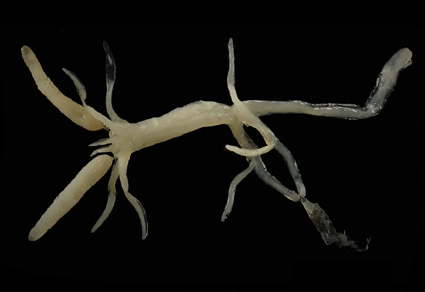Abstract
The parasitic copepod Thysanote rastrelligeri Rangnekar, 1962, was originally described from the branchial cavity of the Indian Mackerel, Rastrelliger kanagurta (Cuvier, 1816) and it has not been reported after its original description. The type specimens of T. rastrelligeri are unavailable, so we provide herein a complementary description of the species based on fresh materials collected from the body surface of the Torpedo scad Megalaspis cordyla (L. 1758), obtained from the fish market at the Kerala coast, India. Thysanote rastrelligeri can be identified based on the following important features: presence of two pairs of maxillary processes; cephalothorax longer than trunk; presence of four simple posterior trunk processes, two dorso-laterals and two ventro-laterals; uropods about 0.5 times as long as posterior processes. Torpedo scad is considered as the new host record and the body surface, a new site of attachment.
References
- Aneesh, P.T., Helna, A.K., Kumar, B.A. & Venmathi Maran, B.A. (2021a) A new species of parasitic copepod of the genus Lernaeenicus Le Sueur, 1824 (Siphonostomatoida: Pennellidae) from the Torpedo scad Megalaspis cordyla (Linnaeus) off Kerala coast, India. Marine Biology Research, 17 (1), 1–11. https://doi.org/10.1080/17451000.2021.1887498
- Aneesh, P.T., Helna, A.K., Prabhakaran, M.P., Ravinesh, R. & Kumar, B.A. (2021b) Complementary description and range extension of an unusual caligid copepod Anchicaligus nautili (Willey, 1896) (Copepoda: Siphonostomatoida) parasitizing the endangered deep-sea cephalopod Nautilus pompilius Linnaeus, 1758 from the Indian Ocean. Thalassas, 37, 757–766. https://doi.org/10.1007/s41208-021-00331-2
- Aneesh, P.T., Ohtsuka, S., Kondo, Y. & Helna, A.K. (2024) Two new genera and species of the parasitic copepod family Chondracanthidae Milne Edwards, 1840 (Copepoda: Cyclopoida) from deep sea fishes off Suruga Bay, Japan. Acta Parasitologica, 69, 874–888. https://doi.org/10.1007/s11686-024-00820-3
- Aneesh, P.T., Helna, A.K. & Kumar, B.A. (2020) New species of Acanthochondria Oakley, 1930 and Chondracanthus Delaroche, 1811 (Copepoda: Poecilostomatoida: Chondracanthidae) parasitizing marine fishes in Indian coast, with a review on the family Chondracanthidae Milne Edwards, 1840 from India. Nauplius, 28, 1–21. https://doi.org/10.1590/2358-2936e2020014
- Aneesh, P.T., Helna, A.K., Kumar, B.A. & Venmathi Maran, B.A. (2018) Redescription of Lernaeenicus stromatei Gnanamuthu, 1953 (Copepoda: Siphonostomatida: Pennellidae) infesting the Black Pomfret Parastromateus niger (Bloch) from Indian waters. Zootaxa, 4482 (2), 375–382. https://doi.org/10.11646/zootaxa.4482.2.9
- Aneesh, P.T., Helna, A.K., Kumar, B.A. & Venmathi Maran, B.A. (2023) Proposal of a new family for Hirodai ohtsukai gen. et sp. nov. (Crustacea: Copepoda) infesting Uranoscopus guttatus Cuvier, 1829 (Perciformes: Uranoscopidae) from the southwest coast of India. Journal of Natural History, 57, 33–36 + 1495–1515. https://doi.org/10.1080/00222933.2023.2259556
- Anonymous (1999) International Code of Zoological Nomenclature. International Commission on Zoological Nomenclature, London, xxx + 306 pp.
- Castro Romero, R., Montes, M.M. & Martorelli, S. (2022) Maxiclavella and Praeclavella (Siphonostomatoida: Lernaeopodidae) new genera confirmed by molecular and morphological evidence. Anais da Academia Brasileira de Ciências, 94 (4), 1–20. https://doi.org/10.1590/0001-3765202220200992
- Fricke, R., Eschmeyer, W.N. & van der Laan, R. (2025) Catalog of fishes: genera, species, references. Available from: http://research.calacademy.org/research/ichthyology/catalog/fishcatmain.asp (accessed 9 March 2025)
- Froese, R. & Pauly, D. (Eds.) (2024) FishBase. World Wide Web electronic publication. Version September 2009. Available from: www.fishbase.org (accessed 9 March 2025)
- Heller, C. (1865) Crustaceen. Reise der Österreichischen Fregatte Novara um die Erdre, in den Jahren 1857, 1858, 1859 unter den Befehlen des Commodore B. von Wüllerstorf-Urbair, Zoologischer Theil. Kaiserlich-Königliche Hof- und Staatsdruckerei, Wien, 280 pp.
- Huys, R. & Boxshall, G.A. (1991) Copepod evolution. The Ray Society, London, 468 pp.
- Kabata, Z. & Tareen, I.U. (1981) A new species of Thysanote Kroyer, 1863 (Copepoda, Lernaeopodidae) from the Persian Gulf, with comments on the genus. Systematic Parasitology, 3, 97–103. https://doi.org/10.1007/BF00012215
- Kirtisinghe, P. (1964) A review of the parasitic copepods of fish recorded from Ceylon, with descriptions of additional forms. Bulletin of the Fisheries Research Station, Sri Lanka, Ceylon, 17 (1), 45–132.
- Nordmann, A. von. (1832) Mikrographische Beiträge zur Naturgeschichte der wirbellosen Thiere. Zweites Heft. Mit zehn Kupfertafeln, G. Reimer, Berlin, XVIII + 150 pp., pls. I–X.
- Piasecki, W., Ohtsuka, S. & Yoshizaki, R. (2008) A new species of Thysanote Kroyer, (Copepoda: Siphonostomatoida: Lernaeopodidae), a fish parasite from Thailand. Acta Ichthyologica et Piscatoria, Szczecin, 38 (1), 29–35. https://doi.org/10.3750/AIP2008.38.1.04
- Pillai, N.K. (1985) The Fauna of India. Copepod Parasites of Marine Fishes. Zoological Society of India, Calcutta, 900p.
- Pillai, N.K., Prabha, C. & Balaraman, K. (1982) Four species of lernaeopodid copepods new to the fauna of India. Journal of the Marine Biological Association of India, 19 (1), 10–15.
- Pillai, N.K. (1967) Copepods parasitic on Indian marine fishes—a review. Proceedings of Symposium on Crustacea, Cochin, 5, 1556–1680.
- Prabha, C. & Pillai, N.K. (1981) Thysanote polyfimbriata, a new lernaeopodid copepod parasitic on Epinepheles in Kerala waters. Records of the Zoological Survey of India, 79 (1–2), 179–185. https://doi.org/10.26515/rzsi/v79/i1-2/1981/161763
- Pearse, A.S. (1952) Parasitic crustaceans from Alligator Harbor, Florida. Quarterly Journal of the Florida Academy of Sciences, 15 (4), 187–243.
- Rangnekar, M.P. (1962) Copepods parasitic on fishes of Bombay. l. Lernaeopodoida. Journal of the University of Bombay, 29 (3–5), 193–205.
- Song, D.X. & Chen, G.X. (1976) Some parasitic copepods from marine fishes of China. Acta Zoologica Sinica, 22 (4), 406–424.
- Steenstrup, J.J.S. & Lütken, C.F. (1861) Bidrag til kundskab om det aabne havs snyltekrebs og lernæer samt om nogle andre nye eller hidtil kun ufuldstændigt kjendte parasitiske Copepoder. Kongelige Danske Videnskabernes Selskabs Skrifter, Naturhistorisk og Mathematisk Afdeling, Kjöbenhavn, Series 5, 5, 343–432. https://doi.org/10.5962/bhl.title.59539
- Walter, C. & Boxshall, G.A. (2025) World of copepods database. Available from: http://www.marinespecies.org/copepoda (accessed 9 March 2025)
- Wilson, C.B. (1913) Crustacean parasites of West Indian fishes and land crabs, with descriptions of new genera and species. Proceedings of the United States National Museum, 44 (1950), 189–227. https://doi.org/10.5479/si.00963801.44-1950.189
- Yamaguti, S. (1939) Parasitic copepods from fishes of Japan. Part 6. Lernaeopodoida, 1. In: Volume Jubilare pro Prof. Sadao Yoshida, 2, pp. 529–578.


